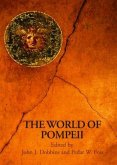In Roman mythology, fauns are place-spirits (genii) of untamed woodland. Romans connected their fauns with the Greek satyrs, wild and orgiastic drunken followers of Bacchus (Greek Dionysus). However, fauns and satyrs were originally quite different creatures. Both have horns and both resemble goats below the waist, humans above; but originally fauns had goat-like hooves, satyrs human feet. The Romans also had a god named Faunus and goddess Fauna, who, like the fauns, were goat-people. The Barberini Faun (Glyptothek, Munich, Germany) is a Hellenistic marble, c. 200 BC that was found in the Mausoleum of the Emperor Hadrian (the Castel Sant'Angelo) and installed at Palazzo Barberini by Cardinal Maffeo Barberini (later Pope Urban VIII), the patron of Bernini, who heavily restored and refinished it, so that its present 'Hellenistic baroque' aspect may be enhanced.
Bitte wählen Sie Ihr Anliegen aus.
Rechnungen
Retourenschein anfordern
Bestellstatus
Storno








